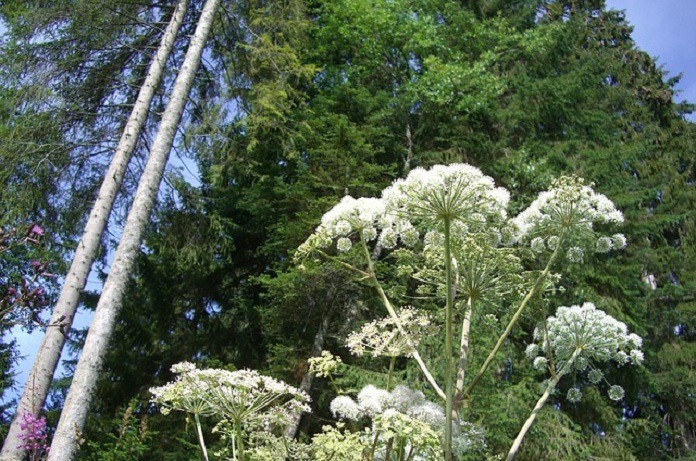Hogweed is a poisonous plant originating from Asia that can be dangerous, causing what is known as Hogweed rash.
Hogweed can cause damage to both the natural environment and to human health
Before becoming an invasive species, it is likely that this exotic plant was introduced to North America as a decorative plant for gardens.
Hogweed is one of the very few plants in North America that can cause damage to both the natural environment and to human health.1
Giant hogweed can grow up to 20 feet in height, with leaves that can measure up to 5 feet wide.1
The weed that burns skin
It is the sap of the hogweed that contains certain chemicals that can lead to serious inflammation of the skin – as early as 15 minutes after contact.2
This toxic sap is located in all parts of the plant and may leave scars on your skin that can last up to six years.2
Hogweed sap causes these serious burns, it prevents the skin from being able to protect itself from any sunlight.2
For this reason, hogweed burns can be compared to extremely severe sunburns.
What should we do to minimize the risk of hogweed burns?
To minimize the risk of hogweed burns when coming in contact with the plant, it is crucial to never touch the sap with bare skin.
There is increasing public awareness of this weed that burns the skin.
It is expected that this increased awareness will lead to better first-aid measures and awareness of what to do.
The skin should be immediately rinsed with mild soap and water after coming into contact with the plant.3
Given the fact that the sap leaves skin vulnerable to extreme burns from the sun, it is important to prevent UV sunlight from reaching your skin- by keeping the area covered.2
What does hogweed rash look like?
Hogweed rash can begin as skin irritation and progress to a painful blistering rash.4
Hogweed sap is so toxic that when it is combined with exposure to sunlight, the rash can leave purple or black scars on the skin.5
Aside from these harsh burns, the sap of hogweed can also cause permanent blindness if it comes in contact with the eyes.5
Hogweed rash treatment
The treatment of rashes and burns caused by hogweed is very similar to those that are used by healthcare professionals when dealing with chemical burns.4
In many cases, oral and topical steroids have been used to reduce the inflammation of the skin that has come in contact with hogweed sap.4
When dealing with severe cases of hogweed burn, it is recommended that these types of steroids are given through intravenous fluid for greater effectiveness.6
There have also been cases of treating third-degree burns caused by hogweed where skin grafts – a surgery used to replace damaged skin with healthy skin – were necessary.7
It is important to act immediately when the skin comes into contact with hogweed sap by, rinsing thoroughly with water and avoiding exposure to sunlight for at least 48 hours.6
Seek medical attention if you are experiencing a hogweed rash.
References
- O’Neill, C. (2007). Giant Hogweed (Heracleum mantegazzianum)-Poisonous Invader of the Northeast NYSG Invasive Species Factsheet Series: 07-1. Sea Grant New York, 1–8.
- Health Hazards & Safety Instructions for Giant Hogweed (with graphic photos) – NYS Dept. of Environmental Conservation. (n.d.). Retrieved July 26, 2021, from https://www.dec.ny.gov/animals/72556.html
- Baker, B. G., Bedford, J., & Kanitkar, S. (2017). Keeping pace with the media; Giant Hogweed burns — A case series and comprehensive review. Burns, 43(5), 933–938. https://doi.org/10.1016/J.BURNS.2016.10.018
- Probert, S. M., Lacey, J., & Gautam, S. (2013). Giant Hogweed burns. Archives of Disease in Childhood, 98(7), 544. https://doi.org/10.1136/ARCHDISCHILD-2012-303229
- Giant Hogweed Heracleum mantegazzianum. (n.d.). Invasive and Exotic Species – Boston. Retrieved July 27, 2021, from http://www.bio.brandeis.edu/fieldbio/Verrill_Wolf/pages/Giant_Hogweed.html
- Pfurtscheller, K., & Trop, M. (2014). Phototoxic plant burns: Report of a case and review of topical wound treatment in children. Pediatric Dermatology, 31(6), e156–e159. https://doi.org/10.1111/PDE.12396
- Chan, J. C. Y., Sullivan, P. J., O’Sullivan, M. J., & Eadie, P. A. (2011). Full thickness burn caused by exposure to giant hogweed: Delayed presentation, histological features and surgical management. Journal of Plastic, Reconstructive and Aesthetic Surgery, 64(1), 128–130. https://doi.org/10.1016/J.BJPS.2010.03.030
- Image by erge from Pixabay



